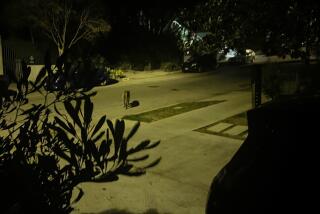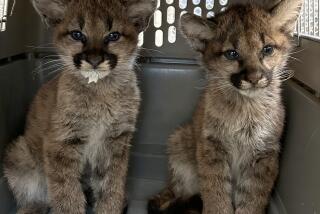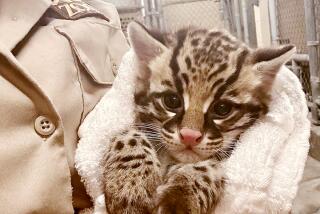Rare Leopard Dies After Flea Bites
- Share via
A rare snow leopard cub at the Los Angeles Zoo has died of anemia caused by flea bites, zoo officials said Tuesday. They said the male cub, one of three born at the zoo about a year ago, showed none of the usual warning signs of infestation by the blood-sucking insects.
Zoo veterinarian Dr. Ben Gonzales said the flea problem is “particularly bad” this summer in some parts of the park, but he and others expressed surprise that the young snow leopard reacted so suddenly.
“We just didn’t see anything that would make alarm bells go off,” leopard keeper Birdie Foster said. “The day before (he died) this cub was taking his nap in his usual relaxed position. . . . We didn’t see fleas until we had our hands on him.”
Foster said the animal had not been scratching or licking itself and had not lost weight, even though it had stopped eating about three days before it died on July 13. County health officials, called in to help treat the flea problem, said it appears the fleas were breeding in an animal run in the snow leopard enclosure that was covered with wet soil and leaves.
Two remaining snow leopards in the enclosure--the cub’s mother and a female sibling--have been dipped and sprayed for fleas and are believed to be healthy, although the exhibit area has been closed indefinitely. (Another sibling was sold to a zoo in Indiana.)
“In retrospect, it’s always easy to look back on these things and say we could have prevented it,” Gonzales said. “If a cat looks absolutely healthy, do you jump on them and decide they have fleas?”
Fewer than a thousand snow leopards remain in the world today. In its native Nepal, the majestic silver-furred cat leads a reclusive and predatory life in the cold crags of the Himalayas. About 350 of the endangered animals live in captivity, including 200 in U.S. zoos. According to Gonzales, unlike domestic cats and even some wild ones such as lions that allow themselves to be petted by keepers, snow leopards are “standoffish” and are not easily examined by doctors except under anesthesia, which itself can be risky to the animal.
An independent veterinarian noted that big cats sometimes do not scratch when they have fleas. “The only way the keeper would have known (about the fleas) is if there were fleas actually biting the keeper,” said Dr. Richard L. Shackelford, a Pasadena veterinarian.
Enclosure Not Sprayed
A zoo spokeswoman said the snow leopard enclosure, known as the China Pavilion because it was built for the giant pandas that visited Los Angeles in 1984, was not treated for fleas until the leopard died.
“This zoo does not have a history of a major flea problem,” the spokeswoman, Lora LaMarca, said. “This exhibit has never had fleas, and we never have fleas with our other big cats.”
More to Read
Sign up for Essential California
The most important California stories and recommendations in your inbox every morning.
You may occasionally receive promotional content from the Los Angeles Times.













